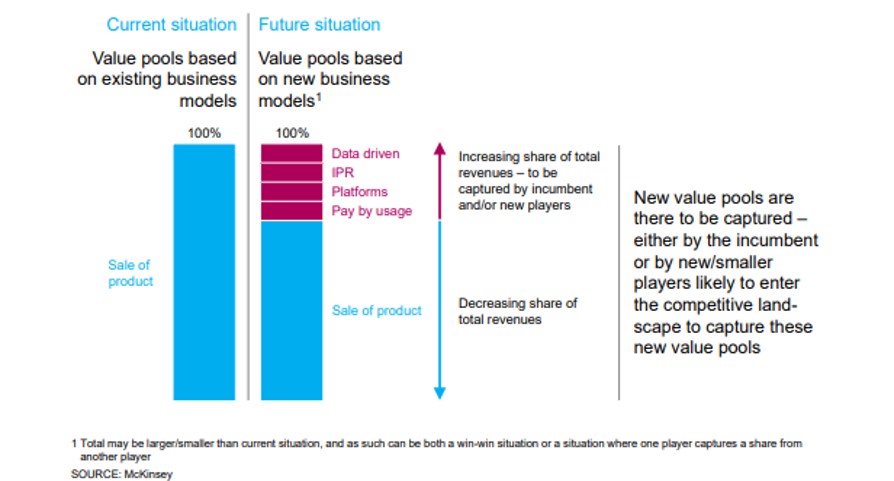
Servitization - The Win Win Model
"Professor Klaus Schwab, founder and executive chairman of the World Economic Forum, identified servitization as one of the megatrends that will shape the future of business and society."
Introduction
To stay competitive, an organization’s leadership constantly evaluates its products, offerings, business models, and processes. This constant evaluation has led to new products and business models such as servitization. Servitization is a business model where customers pay for the services they use instead of purchasing an entire product. For example, in 1962, Rolls Royce introduced “Power-by-the-Hour” to support the Viper engine on the Hawker Siddeley 125 business jet. Customers paid a fixed cost based on flying hours for the engine and accessory replacement services by the company.
Servitization comes in many forms and is a gradual transformation. The image below shows the different phases of servitization as manufacturers move from core product offerings to a platform and ecosystem-centric business model.

Source: Porsche Consulting | Beyond the product
Image 1. Phases of servitization and current industry adoption percentage
In this article, we look at how servitization can bring value to a company and the implications of a servitization-focused business model for hi-tech and manufacturing companies.
Value of servitization model: A win-win
Servitization benefits customers by converting large capital expenditures into operating expenses to pay only for services spread over the years. It allows access to higher quality and better-performing products without worrying about installation, repair, and maintenance. It is especially advantageous for products with infrequent or temporary use. Customers can pay as they use.
So, why should manufacturers embrace it?
The model offers various benefits for manufacturers such as:
- Higher profit margins – According to a McKinsey report, typical margins on new product sales are about 10%, while aftermarket service margins average up to 25%, boosting corporate performance. Research by Porsche consulting observed that companies focused on servitization consistently have higher total shareholder return (TSR). Successful service transformations deliver high TSRs that exceed other industry players.

Source: Porsche Consulting | Beyond the product
Image 2. Median TSR of servitized companies compared to others
- Stronger customer relationships – Correct implementation of servitization model helps build stronger relationships. In a market filled with similar products, services are the true differentiator. A deep understanding of customer requirements, responsive service teams, and better equipment utilization build stronger customer relationships.
- Recurring income stream – While selling products is one-time revenue, servitization is a subscription-based model that generates regular income. It also keeps away competitors by having multi-year contracts instead of one-off sales.
- Upsell products/services – Servitization provides manufacturers the opportunity to upsell new products and subscriptions and generate streaming revenues by embedding service delivery capabilities such as software downloads. For example, Tesla offered to sell its electric vehicle (EV) customers software that adjusts the car’s suspension settings to provide more road clearance at higher speeds. Such upgrades are sources of additional revenues that enable companies to upgrade multiple devices without deploying maintenance personnel or causing inconvenience.
- New revenue streams – Servitization creates many possibilities for manufacturers to develop entirely new businesses. By using smart and connected products, manufacturing companies can better understand the customer experience to predict their needs. For example, connected cars create new revenue-generating businesses such as mobile advertising. Imagine a scenario of you driving your vehicle and getting personalized, location-based offers on your dashboard infotainment system — a hotel five miles ahead offering a 20% discount or a movie theater with tickets available for your favorite movie.
Implications of servitization
Servitization is the next big thing offering multiple benefits for customers and companies. Before hopping on the servitization bandwagon, it is essential to understand the implications of shifting to the model.
- Value pools will change – As more and more companies take the servitization route, there will be a shift in value pools. Historically, product sales have been the largest value pool for manufacturers in terms of the proportion of overall expenditure. This share will likely reduce in the future as servitization gains popularity. For example, connectivity in the automobile sector can distribute revenues between five major revenue pools — vehicle price, connectivity hardware, driver time and attention, maintenance, and insurance.

Image 3. Changing value pools due to servitization
- Long-term play – Servitization will rarely drive short-term growth. In fact, in the short term, companies may have to deal with a decline in revenue and invest in building relevant service capabilities. Profits will be realized over time. A transition period as such will be inevitable and can only be mitigated to an extent.
- Need for digital capabilities – Servitization depends on adopting the right technologies. The Internet of Things (IoT), sensors, artificial intelligence (AI), and machine learning (ML) are crucial to generate data and gain insights. Companies will have to improve digital capabilities with connected operations and a modern digital workplace where employees can connect seamlessly, anywhere, anytime, and on any device.
- Change in employee mindset – The shift to a service-based model impacts the nature of the business. Employees will have to focus more on customers and their needs over continuously perfecting the product. It can be a challenge for seasoned industry veterans to adapt to new methods. However, when shown the benefits of servitization and empowered with the right tools, the shift in working culture can become more manageable.
Conclusion
Servitization will be an essential business model for industries in the future. The decision to adopt servitization requires leadership commitment, strategic planning, and effective execution. Manufacturers can reap the benefits of servitization and capitalize on the endless opportunities with the proper growth mindset, strong leadership, and the right partner for transformation.

